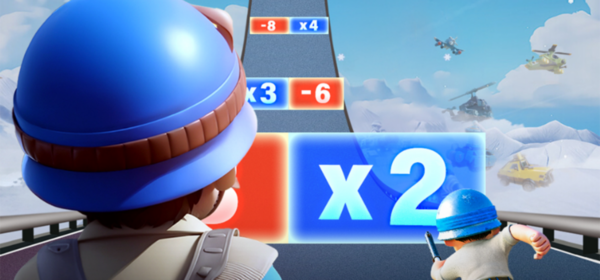Tips for creating events in F2P projects from Rocket Jump
How to work correctly on events in free–play games, what should not be done, and what, on the contrary, should be paid attention to, – he told App2Top.ru the leading game designer of Rocket Jump Andrey Tarasenko.

Andrey Tarasenko
In-game events or events fuel interest in the project both among the active audience and among users who have started to get bored within the core gameplay.
For the audience of the project, this is an opportunity to get acquainted with a new type of gameplay (or otherwise look at familiar mechanics) and get fresh unique content. For developers, it is an opportunity to try out new monetization methods.
A competently implemented event is one that pleases players and brings profit to developers. Let’s figure out what features distinguish a good event, and what you should think about during its development.
Choosing the theme for the event
First you need to choose the right theme of the event. Here we pay attention to three aspects:
- real holidays;
- matching the setting;
- matching the audience profile.
Let’s focus on each of the aspects in detail.
1. Real holidays
First of all, you need to pay attention to the real holidays that are celebrated in the countries where the target audience of your project is concentrated. If you put them in the basis of the event, then you do not have to explain their features to the players.
Many international holidays (Halloween, New Year) are consumer holidays, and the audience will be set up to make in-game purchases.
However, be careful — you should not take as a basis purely religious holidays or those that affect ethically subtle points. So, for the American Memorial Day, instead of selling items, it is better to distribute gifts — otherwise users in the United States may not understand you.
If there are no popular holidays on the dates you need, then it’s better to come up with your own than to take unpopular ones from real life. After all, you can always choose a suitable topic for your audience, taking into account its interests.

2. Matching the audience profile
Events should relate to the gaming audience. We are talking about both gender and regional binding.
It’s hard for American housewives to understand our Victory Day. In Arab countries, the Easter event may not be perceived. And that’s fine. Understand who is playing your game and take into account the specifics of the audience. At the same time, of course, there are universal “hooks” for everyone.
For example, almost any man, whether he is from Russia or Saudi Arabia, is interested in beautiful cars, so it is quite possible to put a virtual sports car in an event store.
3. Matching the setting
Everything is simple here — do not turn the game into trash if the theme of the event does not fit well into the overall concept.
Valentine’s Day in the classical sense (with Cupids and hearts) can be adapted to a fantasy RPG or a humorous shooter like Team Fortress 2. But in survival horror about zombies, you will either have to abandon this idea, or greatly rework the main attributes of the holiday.
Why create an event?
The event is not just a cool idea. It is a tool that is used to achieve certain goals. From a product point of view, the main goals may be, for example, as follows:
- increasing DAU / Retention;
- increased gaming activity/ session duration;
- increase ARPDAU;
- increasing the share of the paying audience.
In addition to the general goals, there may be additional ones — they are set before a specific event. For example, it can be created to take the accumulated resources of users out of the game.
Event structure
To achieve the set goals, the event must be a well-thought-out system containing:
- content (unique items, entourage and rewards);
- game mechanics;
- economy;
- gameplay.

- The player should see a valuable reward — something for which he should fight.
- To get it, he passes tests — blocks using game mechanics and unique content / resources (growing ten unicorn trees for the prize will be more attractive than growing ten ordinary apple trees, with which the user fiddles in the main gameplay cycle).
- The economy is built around the use of event resources and mechanics.
- And the economy, in turn, determines the form of the gameplay — what and at what speed the player will do.
- The event is limited in time. The developer knows how much rewards and content the player will be able to master both without additional expenses and with them. Hence the opportunity for monetization.
Event Economics
From the point of view of development, the cornerstone of events is considered to be the economy. Due to time constraints, events motivate the audience to change the usual game cycle. They promise great opportunities, but they can also cause serious damage to the in-game balance of resources if configured incorrectly. That’s why we strive to pay great attention to the economics of events.
Let’s consider three types of event economy in an F2P game.
1. The event has a separate economy. In this case, it does not affect the main gameplay and the player’s progress in any way. The plus here is that we do not “accelerate” the inflation of the “big” economy in any way and distract players from it with fresh gameplay. Minus — if the monetization depth of the event is less than that of the main gameplay, the project’s profit may temporarily decrease. In fact, this is how we “delay” the player’s resources in core gameplay and prolong the life of the main economy.
2. The economy of the event is strongly tied to resources from the main gameplay. In this scenario, we motivate users to increase turnover in the project economy. Inflation is “accelerating”, we are raising the average check for a short distance, but this may create a problem in the future. In order for the main economy not to exhaust itself ahead of time, it is worth taking care of the creation of compensation mechanisms that will “unload” the players’ resources from time to time. It can be both other events and internal mechanics like fusion (the ability to “merge” several items / cards/units into one more powerful one).
3. The event is tied to both its own and the main economy. The advantage of this type is that we can involve players in the gameplay of the event without sacrificing the rest of the progress. In such cases, the exchange of basic resources for event entities is usually implemented, which allows you to withdraw items accumulated by users from the game. There is also a drawback — players often feel that during such events the cost of receiving valuable awards increases markedly. Therefore, it is worth creating unique valuable rewards that participants will not be able to receive in any other way. Of course, this increases the cost of developing the entire event.

Tips for working with the audience during the event
In our Dakota: Farm Adventures project, we have gained valuable experience in holding various types of events. Here are some tips on the topic that are relevant for casual games, in particular for farms and bodybuilders:
1. Don’t break the balance
Obviously, but. At the end of the event, its participants should receive a reward, while the prize should not give permanent gameplay advantages, otherwise it will greatly affect the overall balance. The reward can be a beautiful “cosmetics” that will remind you of the atmosphere of the holiday and the efforts spent on getting it. It may have practical benefits — a buff or a bonus to resources — but its use should be limited to a small time interval.
2. Remember about the “latecomers”
An impressive part of the users will not start the event from the very beginning. If it is divided into several phases, and each subsequent one depends on the outcome of the previous one, remember about the “latecomers” — even by the end of the event, new players should be able to join the development of content.
Example: we offered players to upgrade their reputation with a flower merchant. In the second phase of the event, users had to sell roses collected at the location, but the merchant accepted the goods only from those who had sufficiently pumped their reputation. As a result, part of the audience, which joined the gameplay only in the second phase, was left out.
3. Don’t motivate with inconveniences
This applies primarily to the development of the interface and usability. If the event involves a separate window with information or mechanics that do not require the presence of a character in a certain place, make this window accessible from any game screen. Do not force users to go to the event location once again, because “it is necessary”.
4. Keep an eye on the viralka
Social and viral mechanics in the framework of events can show themselves unpredictably. Remember that not all users of your project have many friends who also play the game and are ready to support them. If the passage of the event implies a mandatory exchange of items between players, this part of the audience will face unforeseen difficulties.
5. Think of different ways to get rewards
In a well-designed event, the user can come to the reward in different ways. The same applies to monetization — segment event purchases taking into account different cohorts of the audience and average receipts. The study of the monetization depth implies that during the event, users of various categories, and not just “whales”, can make it easier for themselves to master the content.
6. Arrange the right promotions
An action timed to the event can give an increase in profits for the project and attract new players. Don’t be afraid to make big discounts and offer really a lot of resources for less money — during the event, players can make a payment that they would have refused in another situation. Event resources can be sold at all with the highest discounts if they do not affect the main economy.
Conclusion
It is important to remember that creating events is an iterative job. You must constantly keep your finger on the pulse of the audience, monitor its interests, measure the indicators of the in-game economy, improve mechanics and improve the usability of interfaces. There is no limit to perfection, and in this material we have not touched on all aspects of event development. However, understanding the general structure, the main economic types and subtleties of working with the audience is the most important foundation on which events are created. If you have examples from personal practice, we suggest sharing them in the comments.
And now let’s briefly summarize the results.
- Getting started with the event, decide who your audience is and what parameters it has (age, gender, geography, life experience).
- If you can’t schedule an event to coincide with a well-known real holiday, come up with your own.
- Make sure that the theme does not run counter to the concept of the game and the interests of the audience.
- Decide how the economy of the event will interact with the economy of the main game, think about promotions.
- Don’t add rewards that may upset the balance of the game in the long run.
- Pay attention to social and viral mechanics, remember about the convenience of UI/UX.
- Adapt event sales for all categories of paying players.
